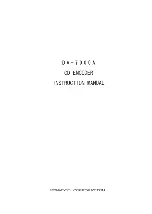
OPERATION
- CAUTION : DO NOT USE THIS INVERTER WITH THE FOLLOWING:
• Small battery operated appliances such as RECHARGEABLE FLASHLIGHTS, SOME RECHARGEABLE
SHAVERS and NIGHT LIGHTS that are plugged directly into as RECEPTACLE TO RECHARGE
• BATTERY CHARGERS used with certain power tool battery packs. These chargers will have a WARNING
LABEL stating that DANGEROUS VOLTAGE ARE PRESENT AT THE CHARGERS BATTERY
TERMINALS.
-WARNING:
Batteries contain corrosive materials and present an Energy Hazard. To prevent irritation and burns, wear
protective wear and clothing, and take special care to ensure no metal tools or personal objects contact the
battery terminals.
-The Power Source Connection
The power source must provide between 10.3 to 15.6 Volts DC and must be able to supply the necessary
current to operate the load. The power source may be a battery or a well-regulated 12V/30A DC power
supply. To obtain the power source must deliver (in amperes), you can divide the power consumption of the
load (in watt) by 12 (the input voltage). For example, the load is rated at 150 Watts, the power source must
be able to deliver: (150/12)=12.5 Amp.
The inverter is equipped with a heavy duty DC lighter plug that fits standard vehicle cigarette lighter and DC
power outlets. With this lighter plug, the inverter can power loads up to 150 Watts.
When continuously powering loads rated higher than 150 Watts, connect the inverter directly to a 12 Volt
battery, please use the provided battery clip cables (PINV2/ PINV3) to connect the inverter directly to the 12
Volt power source. the PINV1 is not suitable for operating at power requirement are over than 150 Watts.
While using the battery clip cable of PINV2 /PINV3, please follow these steps:
A. Cut the lighter plug off the PINV2 / PINV3 power cord.
B. Turn off the power switch and be sure no flammable fumes are present.
C. Connect the BLACK cable to the black post (-) and RED cable to the red post (+) on the rear of the
PINV2/PINV3. Then connect the BLACK battery chip to the NEGATIVE (-) terminal and RED battery chip
to the POSITIVE (+) terminal of the battery. The reverse polarity connection will result in a blown fuse and
may cause permanent damage to the inverter. Do not use the system with positive electrical grounding.
D. Be sure to fasten all connections between battery chips and terminals.
3



























